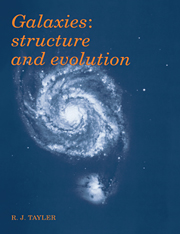Book contents
- Frontmatter
- Contents
- Preface
- Symbols
- Numerical values
- 1 Introduction
- 2 Observations of the Galaxy
- 3 Properties of external galaxies
- 4 Stellar dynamics
- 5 Masses of galaxies
- 6 The interstellar medium in our Galaxy
- 7 The chemical evolution of galaxies
- 8 Galaxies and the Universe
- 9 Concluding remarks
- Appendix 1 Some factors influencing stellar spectra
- Appendix 2 The Virial Theorem
- Appendix 3 Gravitational fields due to spheres and ellipsoids
- Suggestions for further reading
- Index
7 - The chemical evolution of galaxies
Published online by Cambridge University Press: 05 June 2012
- Frontmatter
- Contents
- Preface
- Symbols
- Numerical values
- 1 Introduction
- 2 Observations of the Galaxy
- 3 Properties of external galaxies
- 4 Stellar dynamics
- 5 Masses of galaxies
- 6 The interstellar medium in our Galaxy
- 7 The chemical evolution of galaxies
- 8 Galaxies and the Universe
- 9 Concluding remarks
- Appendix 1 Some factors influencing stellar spectra
- Appendix 2 The Virial Theorem
- Appendix 3 Gravitational fields due to spheres and ellipsoids
- Suggestions for further reading
- Index
Summary
Introduction
A study of the chemical composition of stars in our Galaxy indicates that this composition varies from star to star and that the variation is not random. In particular, there is some correlation between:
(a) Stellar chemical composition and stellar age, and
(b) Stellar chemical composition and stellar position or, more accurately, place of origin.
The correlations are in the sense that the oldest stars and the stars formed in the halo region of the Galaxy have a lower heavy element content than the youngest stars and those formed in the disk. It is not completely clear whether this is one correlation or two. To the accuracy to which stellar ages are known all halo stars could be older than all disk stars and their low heavy element content could just be a consequence of their time of formation. There is, however, also some evidence that halo stars of similar age have very different heavy element content, with those halo stars which were formed furthest from the galactic centre being most deficient in heavy elements. The present estimates of stellar age are not accurate enough to decide whether time of formation is the major factor determining stellar chemical composition or whether there have always been important variations of composition with position.
- Type
- Chapter
- Information
- GalaxiesStructure and Evolution, pp. 147 - 171Publisher: Cambridge University PressPrint publication year: 1993



